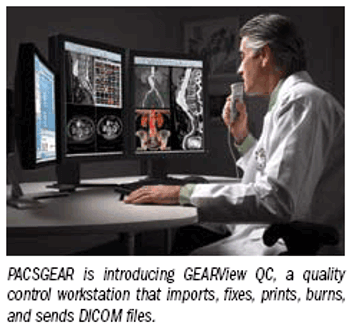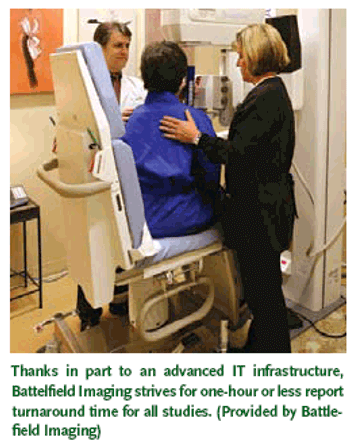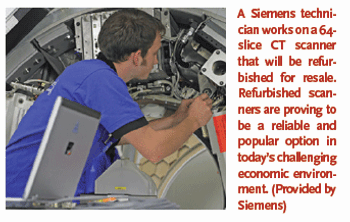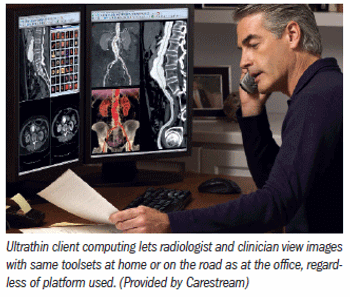
Advanced computing architectures are necessary to support the demands of wide area radiology.

Advanced computing architectures are necessary to support the demands of wide area radiology.

When economic hard times hit, the instinct of most companies is to take shelter, reduce spending, and wait for good times to return.

Old imaging equipment never dies, it just falls into the hands of refurbishers. The practice of refurbishing imaging equipment is not new.

Like devout joggers, thin-client technology keeps getting thinner and thinner. Some clients are now so thin they are virtually transparent.

A five-year hospital audit showed PACS use leads to sustained improvements in productivity and reporting times, according to a recent U.K. study.

Gains attributed directly to healthcare IT are difficult to quantify. A large U.K. study that recently attempted to assess the impact of PACS and computerized physician order entry on clinical and operational efficiencies within the National Health System found each component associated with both increases and decreases in clinical tests and examinations.

Accessing patient information remains a challenge in teleradiology settings, but researchers have found a way to incorporate this information in DICOM image files.

Finding an acceptable way to facilitate distance learning can be a challenge, especially for multicenter residency programs. These programs require residents to rotate through offsite locations, meaning they are frequently unavailable to attend conferences held at the central site.

The Health Insurance Portability and Accountability Act safeguards patient personal health information, but it also tends to complicate medical research by inhibiting access to medical records necessary to develop public health measures.

Major discrepancies in interpretations by teleradiologists and in-house radiologists occur in approximately 6% of commonly ordered CT scans, according to a new paper.

In a foundering national economy, itisn't surprising that capital budgetconstraint has become a huge issuein medical imaging.

The PACS market has changed. It is no longer just about the images.

In the absence of satisfactory 3D viewers, most volumetric medical data is currently viewed as stacks of 2D slices. Yet little research has been conducted on stack mode viewing techniques.


A panel of radiology seers consulted a collective crystal ball during the closing session of the SCAR meeting and attempted to predict what the future holds for radiology in three, 10, and 25 years.

The final 30 minutes of SCAR’s marathon five-hour digital breast imaging forum on Saturday afternoon was allotted to a manufacturers’ panel discussion. Representatives from more than 15 manufacturers fielded questions from the audience.

One way to improve patient care is to expand PACS image acquisition outside the radiology department, attendees at a SCAR scientific session learned this afternoon.

The growth of digital cardiac imaging offers a good opportunity to rethink digital imaging archive strategies by adding cardiology imaging to the radiology PACS archive.

Hype took center stage in an education session at the HIMSS meeting, "Hype aside, what's really happening in U.S. healthcare IT?"

In this era of robust information technology, systems should be improved to address the problems of human error in healthcare delivery, according to a participant in an e-session at the HIMSS meeting Wednesday. At the same time, solutions must be found for the critical problems of productivity in hospitals.

The push toward patient safety and technology effectiveness has begun to loosen the traditional boundaries between the worlds of information technology and clinical engineering.

As cardiac systems develop into full-blown information management and digital imaging networks, hospitals face the decision of whether and how to integrate cardiac PACS with the enterprise/radiology PACS.

Researchers in China have developed a Web-based system to interactively display DICOM-based electronic medical records for intranet and Internet collaborative medical applications. Geared toward improving the efficiency of medical record integration, the setup enables physicians and other users to access and navigate the electronic patient record (EPR) easily from anywhere.

Until recently, the Integrating the Healthcare Enterprise initiative was actually more of an integrating the radiology enterprise.

In this era of robust information technology, systems should be improved to address the problems of human error in healthcare delivery, according to a participant in an e-session at the HIMSS meeting Wednesday. At the same time, solutions must be found for the critical problems of productivity in hospitals.

Today's technology makes it possible for increasingly large networks to share medical information, and HIMSS attendees received an inside look at one Tuesday: a regional collaborative initiative operated by the Massachusetts Health Data Consortium. The initiative promotes the interorganizational exchange of healthcare data using information technology, standards, and administrative simplification. The role of the collaborative is to deliver the goal in seven to 10 years.

If healthcare is willing to change its process and organization, the future can be exciting, Cisco president and CEO John Chambers told a keynote audience at the HIMSS meeting Tuesday morning.

The success of PACS is not in dispute. One-half of all U.S. hospitals in the HIMSS database either have PACS installed or are in the process of implementation.

The days of lugging around the print edition of the American College of Radiology's "Index for Roentgen Diagnosis" may be over for some radiologists. An online computer system that allows searches of the index from any Web browser has surfaced at Harvard University and Beth Israel Deaconess Medical Center.

PACS and image processing techniques are making it possible for surgeons to use virtual endoscopy in certain neurosurgical procedures. The virtual endoscopy technique, which melds CT and MR data, provides accurate presurgical anatomic visualizations that can later be stored in a PACS.

Published: December 14th 2004 | Updated:

Published: November 3rd 2004 | Updated:

Published: March 2nd 2005 | Updated:

Published: June 7th 2005 | Updated:

Published: October 28th 2008 | Updated:

Published: November 4th 2008 | Updated: